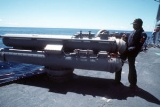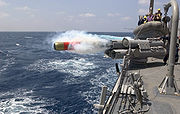
Mark 32 Surface Vessel Torpedo Tubes
Encyclopedia

Torpedo tube
A torpedo tube is a device for launching torpedoes. There are two main types of torpedo tube: underwater tubes fitted to submarines and some surface ships, and deck-mounted units installed aboard surface vessels...
designed for the United States Navy
United States Navy
The United States Navy is the naval warfare service branch of the United States Armed Forces and one of the seven uniformed services of the United States. The U.S. Navy is the largest in the world; its battle fleet tonnage is greater than that of the next 13 largest navies combined. The U.S...
. The Mark 32 has been the standard anti-submarine torpedo launching system aboard United States Navy surface vessels since its introduction in 1960, and in use aboard the warships of several other navies.
Most versions (referred to as modifications or mods) are triple-tube sets that can be rotated or trained to face a target. The exception is the Mod 9 sets, which only have two tubes and are fixed in position. The Mark 36 can fire torpedoes of the Mark 44
Mark 44 torpedo
The Mark 44 torpedo is an obsolete air-launched and ship-launched lightweight torpedo manufactured in the U.S., and under licence in Canada, France, Italy, Japan and the United Kingdom with 10,500 being produced for U.S. service. It was superseded by the Mark 46 torpedo...
, Mark 46
Mark 46 torpedo
Designed to attack high-performance submarines, the Mark 46 torpedo is the backbone of the U.S. Navy's lightweight ASW torpedo inventory, and is the current NATO standard. These aerial torpedoes, such as the Mark 46 Mod 5, are expected to remain in service until the year 2015...
, Mark 50
Mark 50 torpedo
The Mark 50 torpedo is a U.S. Navy advanced lightweight torpedo for use against fast, deep-diving submarines. The Mk-50 can be launched from all anti-submarine aircraft and from torpedo tubes aboard surface combatant ships. The Mk-50 was intended to replace the Mk-46 as the fleet's lightweight...
(from the Mod 17 tubes onwards), and Mark 54 designs, and can be modified to use other torpedoes (such as when the Royal Australian Navy
Royal Australian Navy
The Royal Australian Navy is the naval branch of the Australian Defence Force. Following the Federation of Australia in 1901, the ships and resources of the separate colonial navies were integrated into a national force: the Commonwealth Naval Forces...
modified the Mark 32s aboard its Adelaide
Adelaide class frigate
The Adelaide class is a ship class of six guided missile frigates constructed in Australia and the United States of America for service in the Royal Australian Navy. The class is based on the United States Navy's Oliver Hazard Perry class frigates, but modified for Australian requirements...
and Anzac
Anzac class frigate
The Anzac class is a ship class of ten frigates; eight operated by the Royal Australian Navy and two operated by the Royal New Zealand Navy...
class frigates to fire the MU90 Impact
MU90 Impact
The MU90/IMPACT is an advanced lightweight anti-submarine torpedo used by navies of Germany, France, Italy, Denmark, Australia and Poland. It is designed to compete with and outperform the US-built Mark 46 in the anti-submarine role, and is also available in a special MU90 Hard Kill version for...
). The tubes are designed to be fired remotely, but manual firing controls are fitted as a backup to all but the Spruance class destroyer's
Spruance class destroyer
The Spruance-class destroyer was developed by the United States to replace a large number of World War II-built Allen M. Sumner- and Gearing-class destroyers, and was the primary destroyer built for the U.S. Navy during the 1970s....
Mod 15 sets, as all aspects of the tubes' operation is controlled remotely. The launch is powered by compressed air in a rear flask, which also doubles as each tube's breech
Breech-loading weapon
A breech-loading weapon is a firearm in which the cartridge or shell is inserted or loaded into a chamber integral to the rear portion of a barrel....
, and the torpedoes are fire-and-forget
Fire-and-forget
Fire-and-forget is a third-generation method of missile guidance. The military uses the term for a type of missile which does not require further guidance after launch such as illumination of the target or wire guidance , and can hit its target without the launcher being in line-of-sight of the...
weapons.
The launcher can be made out of fibreglass, or with a fibreglass liner encased in metal. The tubes were designed to be weatherproof and capable of storing torpedoes for long periods, but this is only practical with regular maintenance. Each triple-tube set weighs around 2230 pounds (1,011.5 kg) unloaded, with variations between mods.

